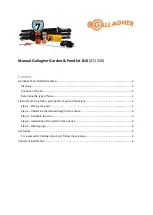
Important Information
Page | 5
©
2021
– Valeport Ltd
3.5.1.4 Rhodamine
Performance
Excitation:
520 nm
Detection:
650 nm
Dynamic Range:
0 - 1000 ppb
Instrument Detection limit:
<0.01 ppb*
Actual Detection limit:
0.06 ppb**
Linearity:
0.99 R
2
Response Time:
0.03 to 2 s
* 3x SD in RO water
** Calibrated against Rhodamine WT solution
3.5.1.5 Sulforhodamine B
Performance
Excitation:
520 nm
Detection:
650 nm
Dynamic Range:
0 - 500 ppb
Instrument Detection limit:
<0.01 ppb*
Actual Detection limit:
0.06 ppb**
Linearity:
0.99 R
2
Response Time:
0.03 to 2 s
* 3x SD in RO water
** Calibrated against Sulforhodamine B solution
3.5.1.6 Phycocyanin
Performance
Excitation:
590 nm
Detection:
650 nm
Dynamic Range:
0 - 9000 ppb
Instrument Detection limit:
<0.01 ppb*
Actual Detection limit:
2 ppb**
Linearity:
0.99 R
2
Response Time:
0.03 to 2 s
* 3x SD in RO water
** Calibrated against Sulforhodamine solution
3.5.1.7 Linear Observation Range
The linear range is the concentration range for which the fluorometer signal is directly proportional
to the concentration of the fluorophore. The linear range starts at the minimum detection limit
(MDL) and extends to the upper limit of the instrument (dependent on fluorophore properties,
optical filters, LED power, sample volume and optical path length).
The optical devices manufactured by Valeport have digital outputs only; at higher concentrations,
unlike analogue devices which generally flat-line at full-scale deflection (e.g. FSD 5V) the
fluorometer will continue to output a signal which increases with concentration (i.e. meaningful
data), though which is no longer guaranteed to be linear.
At very high fluorophore concentrations, signal quenching can occur, whereby the instrument
output does not increase linearly with fluorophore concentration (roll-off) and may decrease at
even higher levels.










































